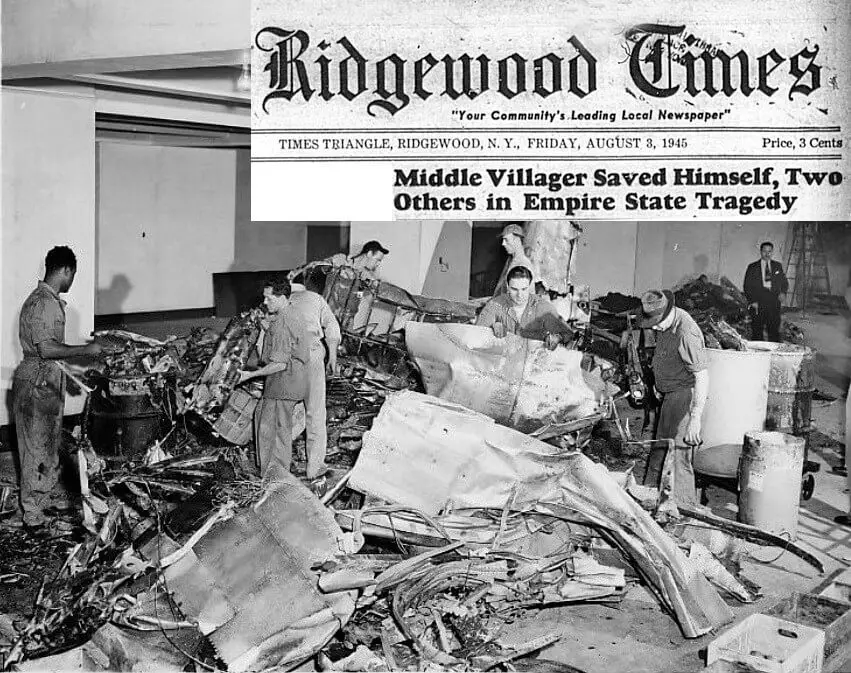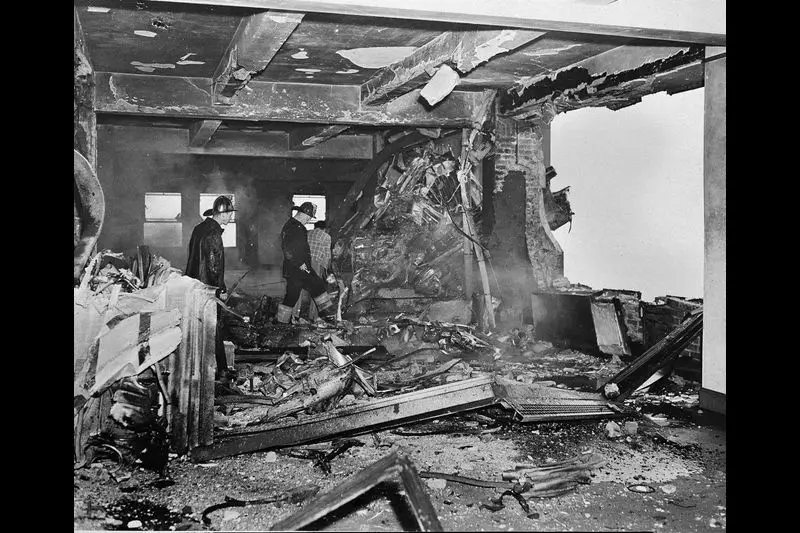As an Amazon Associate, I earn from qualifying purchases.
The crash that shook the city but what was the difference between the empire state building plane crash and 9/11?
A terrible tragedy shook the Empire State Building and the people of New York on July 28, 1945 – that too, on a Saturday. During a normal personnel transport mission (where Lieutenant Colonel William F. Smith Jr. piloted a military B-25 bomber from Bedford Army Air Field to Newark Airport), Smith asked for permission to land the plane. However, Smith was advised that there was heavy fog in the area, and that landing the plane would put the buildings in the Manhattan area at risk.

The decision that Smith made next became a permanent part of the Empire State Building’s history. Smith chose to ignore the plane traffic control’s warning, and proceeded to attempt to land the plane anyway. However, he quickly became disoriented due to the heavy fog, and after passing the Chrysler Building, he took a wrong turn. This would be the deadly decision that would lead to the Empire State Building plane crash.

Who was piloting the plane?
Smith was in fact a decorated pilot who had thousands of hours of experience with planes. He had been awarded several medals at this point, and was a combat veteran as well. But, this was not enough to stop him from making the choice that would lead to deaths, and the Empire State Building plane crash on July 28, 1945 during the routine flight to Newark Airport. Even though he was informed that visibility over the Empire State Building would be limited to three miles, this did not stop him from piloting the B-25 Mitchell bomber downwards into the buildings of New York.
The impact of the Empire State Building plane crash

The crash itself was sudden and caused a massive impact, with a great deal of damage done to the building. The B-25 bomber struck the Empire State Building twenty minutes to 10 PM, between the 78th and 80th floors of the north side of the building. Between these stories, the bomber effectively carved out a massive hole in the offices, destroying the building’s structural integrity. As the B-25 bomber crashed into the building, its parts exploded in various different directions. The Empire State Building wasn’t the only building devastated in the crash – in fact, buildings as far as one block away were damaged as well. One engine was seen flying into a far off building, and it crashed into a penthouse studio. The ensuing smoke and flames entirely destroyed the studio, leaving behind nothing but wreckage. Another engine missed the Empire State Building’s 78th floor entirely, and landed in an elevator shaft, causing a large fire which was put out after a long time. Since the bomber was part of the army and military, it was structurally sound and managed to cause a significant amount of damage when its parts crashed into both the Empire State Building and the surrounding buildings.
Unfortunately, the 86th floor contained a sightseeing observation deck, which at the time was packed with about 60 people. As the B-25 bomber crashed into the Empire State Building, 14 people were killed. Two people that were killed were aboard the B-25 bomber (Staff Sergeant Christopher Domitrovich and Albert Perna), and eleven people were killed within the Empire State Building itself.
What caused the crash to occur?
Looking further into how the crash itself happened, investigators have not been able to establish a solid reason as to why exactly this accident was caused. The leading investigative theory is that Smith saw a river through the heavy clouds on that day, which he thought to be the East River, but it was actually the Hudson River. Smith proceeded to descend to what he presumed was Newark Airport, but it was actually the Empire State Building. Due to the heavy fog, when he realised where he was, it was too late to execute an evasive manoeuvre. Thus, the bomber crashed into the Empire State Building, destroying the 78th and 79th floors. People on the street at the time reported watching the bomber soar through the clouds, narrowly missing the Rockefeller Center, and then disappearing into the heavy fog. July 28, 1945 became a fateful and miserable day for the families of the 14 victims, and multiple others who were injured in the calamity that ensued, even after the bomber had made its mark on the Empire State Building. Several buildings in the city of New York were damaged as well. 25 people also suffered from serious wounds, not counting the 14 casualties from the crash.
The emergency response to the Empire State Building crash was handled well by firefighter response time standards. Minutes after the bomber crashed into the Empire State Building, fire companies were on the scene, and they used the building’s working lifts to extinguish the raging fires. From the streets, people reported seeing a great deal of water flowing down from the hole that the bomber had made in the Empire State Building. Not long after, the firefighters managed to get the flames under control, such that further casualties could be mitigated. In fact, one unlikely hero in this story was a passerby named Donald Maloney. He had been passing by, and he witnessed the accident happen. He made his way into an elevator shaft in order to rescue an unconscious woman – he gave her morphine and rushed her to the hospital, thus saving her life.
What was the aftermath of the incident?
The aftermath of the Empire State Building plane crash has had long-lasting effects on the people of New York City. The Empire State Building was in fact reconstructed such that it could withstand the effect of a similar bomber plane crashing into it again. The damages to the building were very extensive, but the army paid for them as a show of goodwill, and as an apology. Unfortunately, the penthouse studio that was destroyed (belonging to Henry Hering) was not fairly compensated. Although the art that was destroyed was valued at over $100,000, he was offered less than a quarter of that as compensation by the army. Although the loss of life was truly heartbreaking, the Empire State Building was found open for regular business a mere two days after the accident. Luckily, this incident led to a modification in legislature that now allows people to sue the government for this crash and similar accidents. Additionally, the Empire State Building stands tall and proud today, and the July 28, 1945 incident remains the only plane crash-related incident involving the tallest building in New York.
Amazon and the Amazon logo are trademarks of Amazon.com, Inc, or its affiliates.


